Table setting in Russia is a true art that unites the rich cultural heritage and traditions of each region of the vast country. In Russia, table setting is not just arranging dishes and cutlery, but also the embodiment of the Russian soul.
The history of Russian table setting is rich and varied.
An important aspect has always been attention to detail and decoration. From time immemorial, Russian craftsmen created unique patterns and ornaments on dishes, emphasizing national motifs and historical heritage.
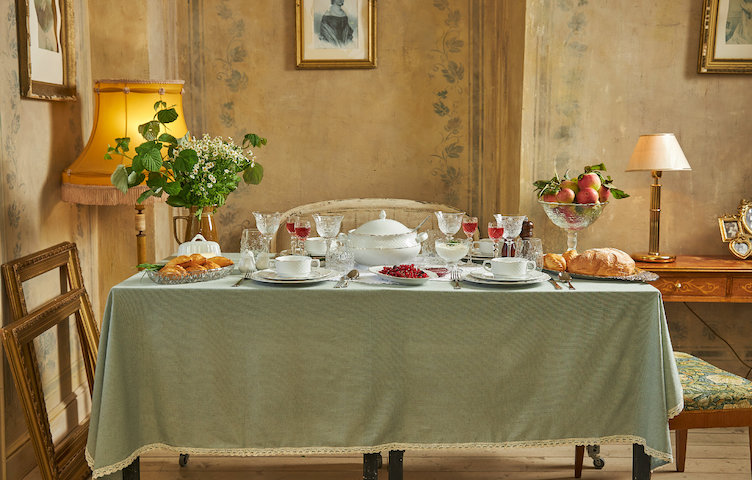
It is known that the origin of the word “dacha” is associated with the verb “to give”. It first gained popularity during the time of Peter I, when the emperor generously granted land to his favorites for outstanding services. Subsequently, entrepreneurs began to build holiday villages with the goal of renting them out for the summer to everyone. Over time, those who refrained from renting a dacha in the summer began to arouse suspicion and distrust in high society. If in the 18th century dachas were available only to aristocrats, then by the end of the 19th - beginning of the 20th century they became part of everyday life for almost all wealthy segments of the population. So, over time, dacha life became a massive and exclusively Russian phenomenon. And slow afternoon teas, joint tea parties and gala dinners became an integral part of dacha life.
In the 19th century, table setting in Russia reached its peak, especially among the nobles. The tables were set with sophistication and luxury. Gold trays, porcelain dishes, salad bowls and sculptural jugs, as well as decorative vases adorned the dining tables of noble estates. This was not only a manifestation of wealth and status, but also a way to create an atmosphere of luxury and provide an unforgettable experience to the guests of the estate.
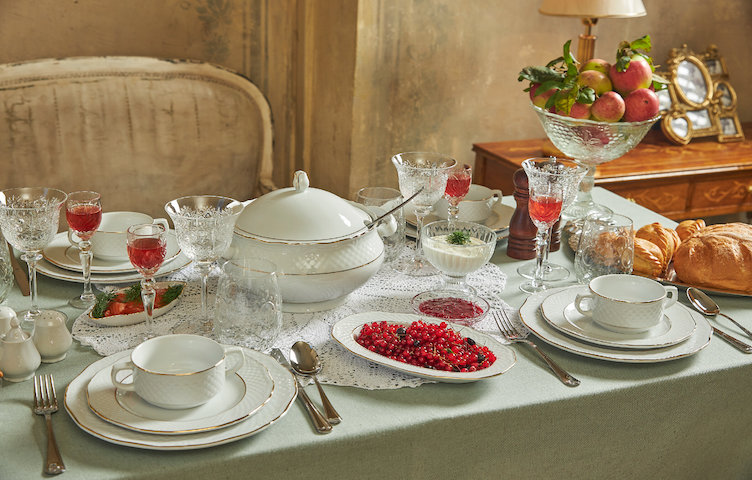
Interesting fact: despite the enormous influence of French culture on the Russian nobility in the 18th-19th centuries, the custom of serving all dishes at once, as was customary in France, did not take root. As D.I. Fonvizin wrote: “The French cook is very good: this justice must be given to her - but... the service at the table is very bad. When I dine at a party (for I never have dinner), I usually have to get up hungry. Often there is food next to me that I don’t want to eat, but I can’t ask for it from the other side, because I’m blind and I don’t see what to ask for. Our fashion for serving dishes is the most sensible.”
Over time, the French themselves recognized the superiority of the Russian tradition of serving all dishes in turn - and by the middle of the century, this type of serving had spread not only in France, but throughout Europe.
It is worth noting that even today, most restaurants with classic Russian cuisine take as their basis the tradition of noble table setting in the 19th century. We also tried to focus on this aesthetic, subconsciously familiar to everyone from classic literary novels and history lessons. In our table setting, we tried to embody the atmosphere of a noble dacha from the works of Chekhov, seasoning it with details from the paintings of Kustodiev and Korovin.
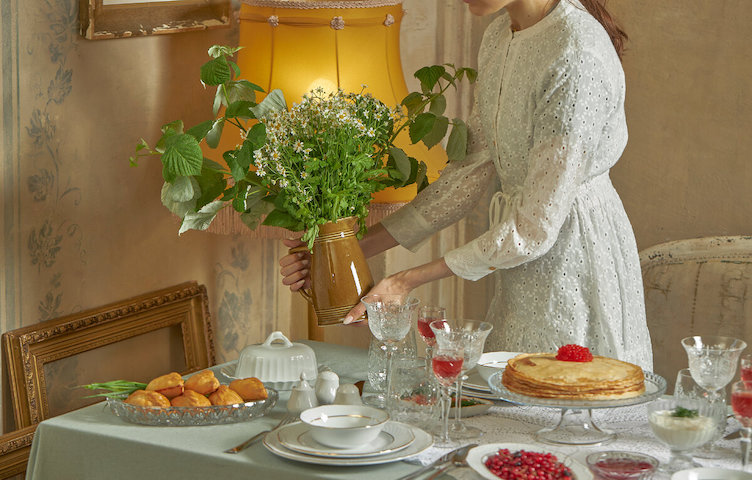
A mandatory attribute of any table setting in noble Russia was the presence of vases for fruits and sweets, large trays and common dishes. That is why we began to form our serving set with the choice of dishes to serve: we thought the theme was a dish from the STEL brand with the image of a rooster’s head. The pancakes took their place in the center of the table on a glass Patisserie stand from Pasabahce . And we placed the apples in a fruit bowl from the “Picnic” series from the Neman brand. The Neman assortment includes a wide selection of tableware in the style of the Russian nobility - for example, crystal wine glasses , decanters and shot glasses with a classic carved pattern, which have taken their rightful place in this table setting. To serve water, juices and fruit drinks, we recommend paying attention to the “Baroque” glasses from Borgonovo - the unusual rounded patterns serve as an excellent reference to traditional Khokhloma painting and echo the design of a fruit vase.
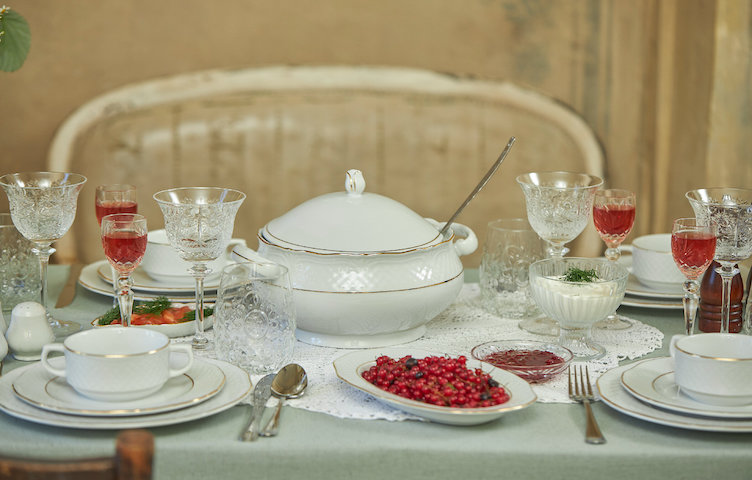
Of course, tableware plays the main role in serving. It is the porcelain tableware that sets the tone and creates the overall mood at the table.
To further immerse ourselves in noble aesthetics, we settled on porcelain from Lubiana, decorated with gold. The “Aphrodite” series was ideal for this purpose, because the assortment includes not only plates of different sizes, but also a chic tureen with a lid, a milk jug, a herring bowl, a sugar bowl and bouillon cups.
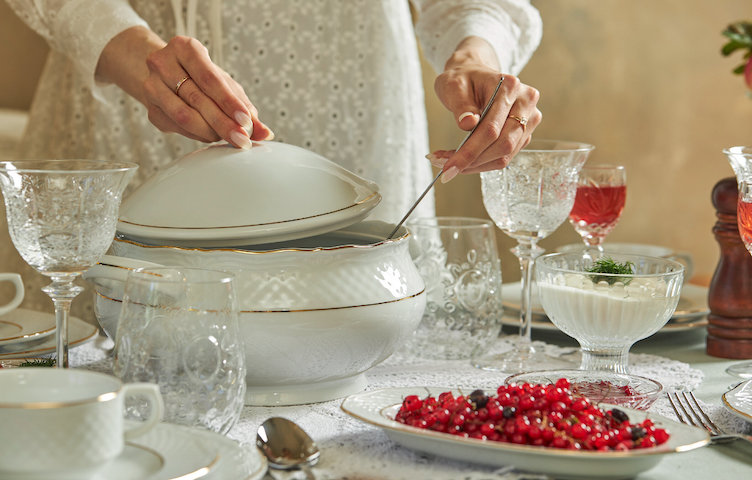
Of course, the tureen is especially important for table setting in the Russian style. Soups in Russian cuisine are not only a cultural heritage, but also the ability to adapt to extreme climatic conditions. Russia is a country with severe cold weather, and in winter warm food becomes an urgent necessity. Historically, soups have been very popular in Russia, and today they have become an integral part of the daily and holiday diet of Russians. We offer to season soups and other dishes using wooden mills from Ilsa, and if you prefer a classic set for spices , then there is no better option than the “Romance” series from the Dobrush Porcelain Factory.
Another important place on the table and in Russian culture is occupied by pies. They symbolize hospitality and warmth of the hearth. It was customary to serve different types of pies with different dishes. For example, meat pies were served with cabbage soup, and pies were served with fish soup. Ceremonial dishes were used to serve pies. For our table setting, we settled on the option from STEL , mentioned earlier.
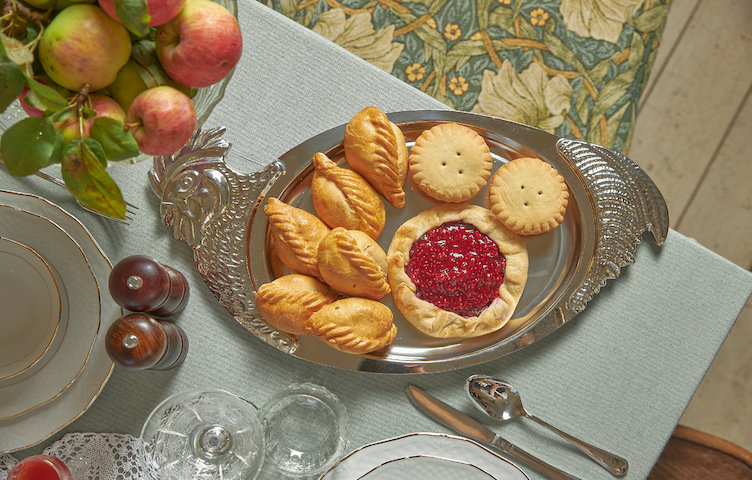
Today, Russian table setting has not lost its significance. Restaurants serving Russian cuisine still adhere to traditions, offering guests not only delicious dishes, but also an unforgettable experience. Russian table setting is a real art that combines rich history and modern trends. She embodies the spirit of hospitality and tradition of Russian culture, and her unique features continue to inspire.
Try and please yourself with serving in the style of the Russian aristocracy and don’t forget to share your discoveries and ideas with your friends and family!
















































/https%3A%2F%2Fcomplexbar.com%2Fimages%2Fblog%2F245%2Frussia-552x600-300.png)
/https%3A%2F%2Fcomplexbar.com%2Fimages%2Fblog%2F244%2F552x600-min-round-corners.png)
/https%3A%2F%2Fcomplexbar.com%2Fimages%2Fblog%2F246%2Fwhite_szh_552x480.png)
/https%3A%2F%2Fcomplexbar.com%2Fimages%2Fblog%2F131%2FAutumn_552x600.png)
/https%3A%2F%2Fcomplexbar.com%2Fimages%2Fblog%2F246%2F2024-04-09_17.22.54.jpg)
/https%3A%2F%2Fcomplexbar.com%2Fimages%2Fblog%2F246%2F2024-04-09_17.22.47.jpg)
/https%3A%2F%2Fcomplexbar.com%2Fimages%2Fblog%2F246%2FCODE_anons_foamydrops_752%D1%85480_eng.jpg)
/https%3A%2F%2Fcomplexbar.com%2Fimages%2Fblog%2F246%2FAlina_752%D1%85480_eng.jpg)
/https%3A%2F%2Fcomplexbar.com%2Fimages%2Fblog%2F246%2F2024-04-09_17.23.22.jpg)
/https%3A%2F%2Fcomplexbar.com%2Fimages%2Fblog%2F246%2F2024-04-09_17.23.28.jpg)
/https%3A%2F%2Fcomplexbar.com%2Fimages%2Fblog%2F246%2F2024-04-09_17.23.35.jpg)
/https%3A%2F%2Fcomplexbar.com%2Fimages%2Fblog%2F246%2Fdrinksome_752%D1%85480_eng.jpg)
/https%3A%2F%2Fcomplexbar.com%2Fimages%2Fblog%2F246%2Fnude_752%D1%85480_eng.jpg)
/https%3A%2F%2Fcomplexbar.com%2Fimages%2Fblog%2F246%2F752%D1%85480_eng__1_.jpg)
/https%3A%2F%2Fcomplexbar.com%2Fimages%2Fblog%2F246%2F752%D1%85480_eng.jpg)
/https%3A%2F%2Fcomplexbar.com%2Fimages%2Fblog%2F246%2FStudioRaw_752%D1%85480_eng.jpg)
/https%3A%2F%2Fcomplexbar.com%2Fimages%2Fblog%2F246%2FDoppio_tea_752%D1%85480_eng.jpg)
/https%3A%2F%2Fcomplexbar.com%2Fimages%2Fblog%2F246%2FTognana_Stars_Stripes_752%D1%85480_eng.jpg)
/https%3A%2F%2Fcomplexbar.com%2Fimages%2Fblog%2F246%2FRona_752%D1%85480_eng.jpg)
/https%3A%2F%2Fcomplexbar.com%2Fimages%2Fblog%2F246%2FDoppio_vending_752%D1%85480_eng.jpg)
/https%3A%2F%2Fcomplexbar.com%2Fimages%2Fblog%2F246%2FEssence_sukhie_smesi_752%D1%85480_eng.jpg)
/https%3A%2F%2Fcomplexbar.com%2Fimages%2Fblog%2F246%2FODK_sukhie_smesi752%D1%85480_eng.jpg)
/https%3A%2F%2Fcomplexbar.com%2Fimages%2Fblog%2F246%2Funiforma-barmena.jpg)
/https%3A%2F%2Fcomplexbar.com%2Fimages%2Fblog%2F246%2Fkak-nanyat-barmena.jpg)
/https%3A%2F%2Fcomplexbar.com%2Fimages%2Fblog%2F246%2Fsirop_scale_2400.jpeg)
/https%3A%2F%2Fcomplexbar.com%2Fimages%2Fblog%2F246%2FPeugeot_Anons_Paris_U%27Select_Line_Daman_752%D1%85480_eng.jpg)
/https%3A%2F%2Fcomplexbar.com%2Fimages%2Fblog%2F246%2Fkofe-vostochniy.jpg)
/https%3A%2F%2Fcomplexbar.com%2Fimages%2Fblog%2F246%2FMadler.jpg)
/https%3A%2F%2Fcomplexbar.com%2Fimages%2Fblog%2F246%2Fprofbartender_glavn.jpeg)